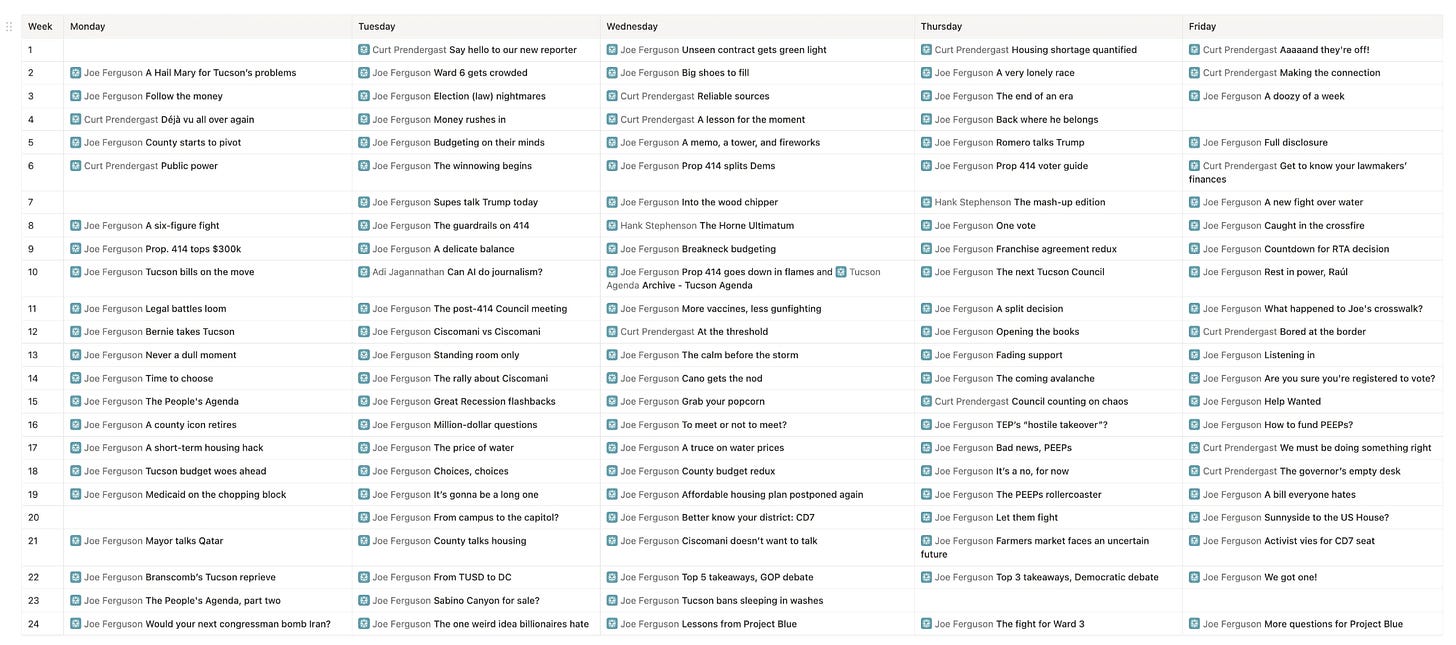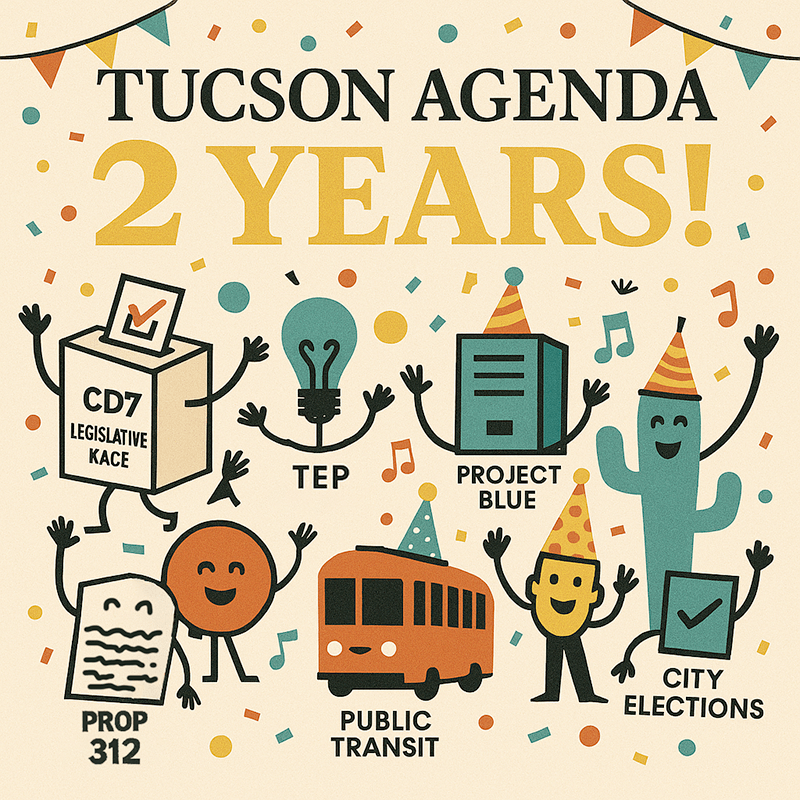Two years, and counting
Help us celebrate a big milestone.
This is a really exciting week for us here at the Tucson Agenda.
We’re celebrating two years since we first started publishing in July 2023. It’s been a wild ride and we’re looking forward to many more years of covering the wacky, the wonky and everything in between.
As always, we couldn’t have done any of it without you, our readers. We rely almost entirely on paid subscriptions to keep the lights on. And we’re thrilled to see a community of readers spring up around our little publication.
So, thank you!
As a special treat for readers who are curious about how the Tucson Agenda comes together, and maybe want to see what their subscription dollars pay for, today we’re giving you a peek behind the curtain.
We’re sharing snippets from our editorial meetings, where we talk about stories we’d like to write, think through public records requests and get the next day’s newsletters ready for publication.
And we’re running through some of our favorite stories of the year so far.
So stick around, and please, click that button if you can.
The Agenda tries to count to a million
One of our core values at the Tucson Agenda is creativity. We’re always looking for innovative ways to make local news interesting.
Writing about budgets is one of the most important, and driest, subjects in all of local news. It’s so easy to get lost in the numbers and miss the big picture, or end up writing sentences that are factual, but incomprehensible to a regular person.
Back in April we wanted to write about the Tucson and Pima County budgets without boring or befuddling our readers.
But first, we had to figure out how to do it, and what to include.
We eventually hit on the idea of framing the story as “what can they buy with $1 million?”
We’d love to get to $1 million in revenue at the Agenda. Right now, we’re just asking for $12.
Border news isn’t about the border anymore
Over the past six months, the Tucson Agenda has merged more thoroughly with the Arizona Agenda and the three verticals we launched in January. It’s what we call the Agendaverse, a family of newsletters with a common goal and shared resources.
So when it came time to write about changes we were seeing at the U.S.-Mexico border, we all put our heads together to see how we should cover them.
Watch us struggle with how to frame the new chaos at the border.
Do you want reporters who think through complicated stories? This magic button makes that happen.
When a story isn’t just a “story”
When you write 250 newsletters a year, one of the challenges is keeping it fresh.
So we’re always watching for ways to improve our storytelling.
Every week, we talk about the types of stories we write (Q&A, public meeting previews, issue analysis, etc.) to make sure we’re not doing the same old thing every time.
In late May, we chatted about what worked well — and what maybe didn’t work so well — as we went through that week’s stories.
Smashing this button helps keep local news fresh.
Taking stock
This week also is the time for our quarterly meeting, which means we’ll be up to our eyeballs in spreadsheets and calendars.
That might sound like a headache, but it’s actually one of our favorite things to do. We get to take stock of the work we’ve done, check our progress on projects, and generally make sure we’re on track with our long-term goals.
When we looked back on the past few months, it was apparent once again that Tucson is home to a vibrant civic community.
Arguments fly back and forth among residents and elected officials and new ideas pop up for everything from the power grid to border politics to the housing shortage.
There was the buildup and eventual crash-and-burn of Prop 414, followed by Tucson officials having to rework their budget plans, while trying to keep public transit free and police officers happy.
The city council balking at making it a crime to sleep in washes before taking the plunge, and then having to deal with the first lawsuit filed under Prop 312.
County officials wrestling with another showdown with the City of Tucson over water rates or closing down shelters for asylum seekers after federal dollars dried up.
Tucsonans pressuring officials to create a city-owned electric utility, while Tucson Electric Power officials pull their hair out.
Both the city and the county dealing with the topic of the moment: the mysterious Project Blue.
Then there’s the chaos caused by the Trump administration’s cuts to federal funding, and the ensuing street protests and scramble by local officials.
All the while, the state Legislature was making decisions that would set the rules for how cities and counties operate, usually while pulling money from local coffers to state ones.
And don’t forget about elections. Every year is an election year in Tucson. This time, we’ve got three seats on the Tucson City Council up for grabs and a special race to fill the shoes of a longtime congressman, not to mention appointing replacements for local officials who retire or decide to run for Congress.
And, of course, we’re needling Republican U.S. Rep. Juan Ciscomani.
Along the way, we gave you some reliable sources to help you understand the complex politics of the U.S.-Mexico border, took a big-picture view of what’s happening with federal funding, and tried to see with clear eyes the encroaching threat of fascism.
That’s what the Tucson Agenda’s news coverage looks like from the outside.
A lot going on, right?
Well, it’s even more complicated — and way more fun — on the inside.






Congrats! You’ve been an important part of my morning routine since I subscribed a few months ago. As someone who went to journalism school in the days when newspapers were king, The Agenda scratches all of my newsie itches.
Congratulations to all of you for informative and engaging reporting! I greatly appreciate this newsletter.